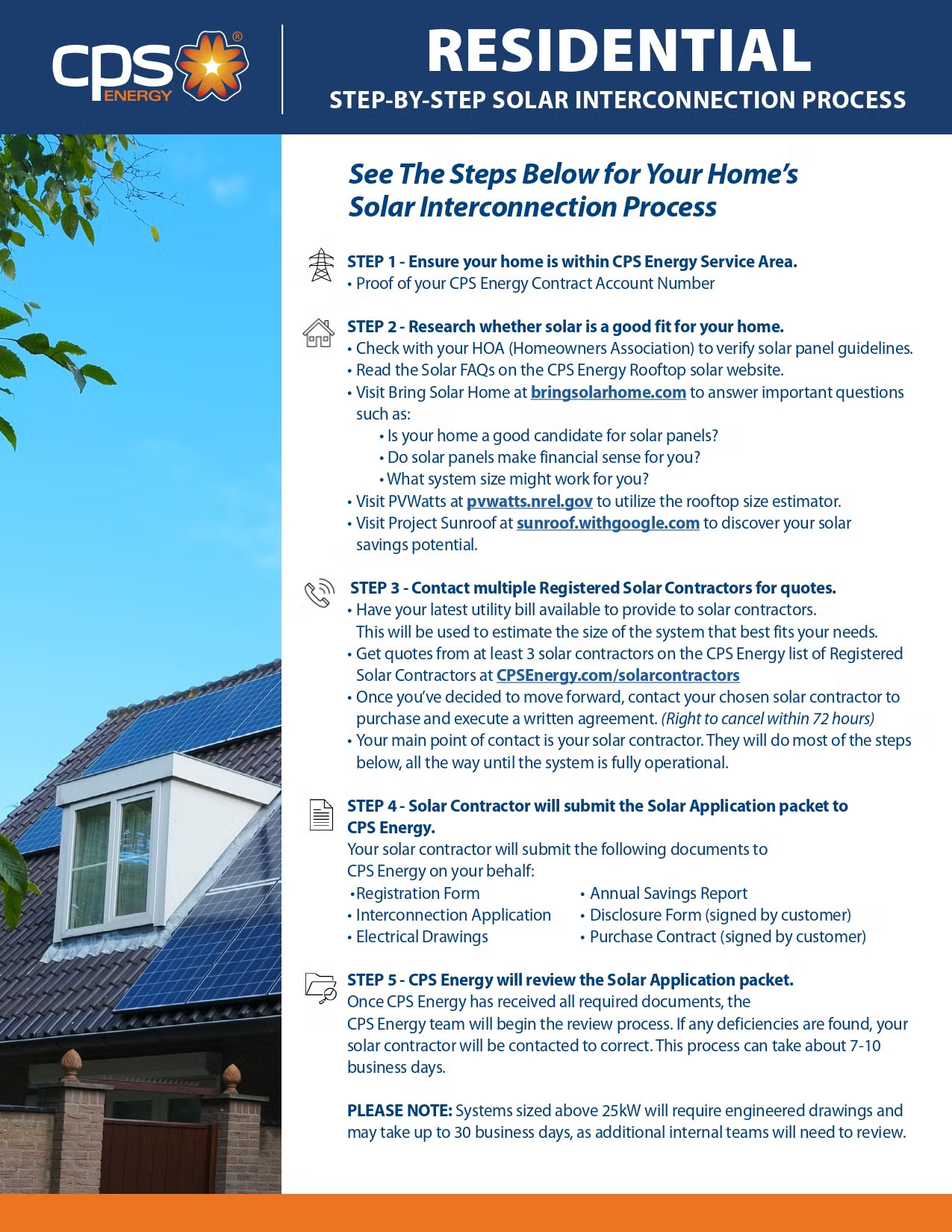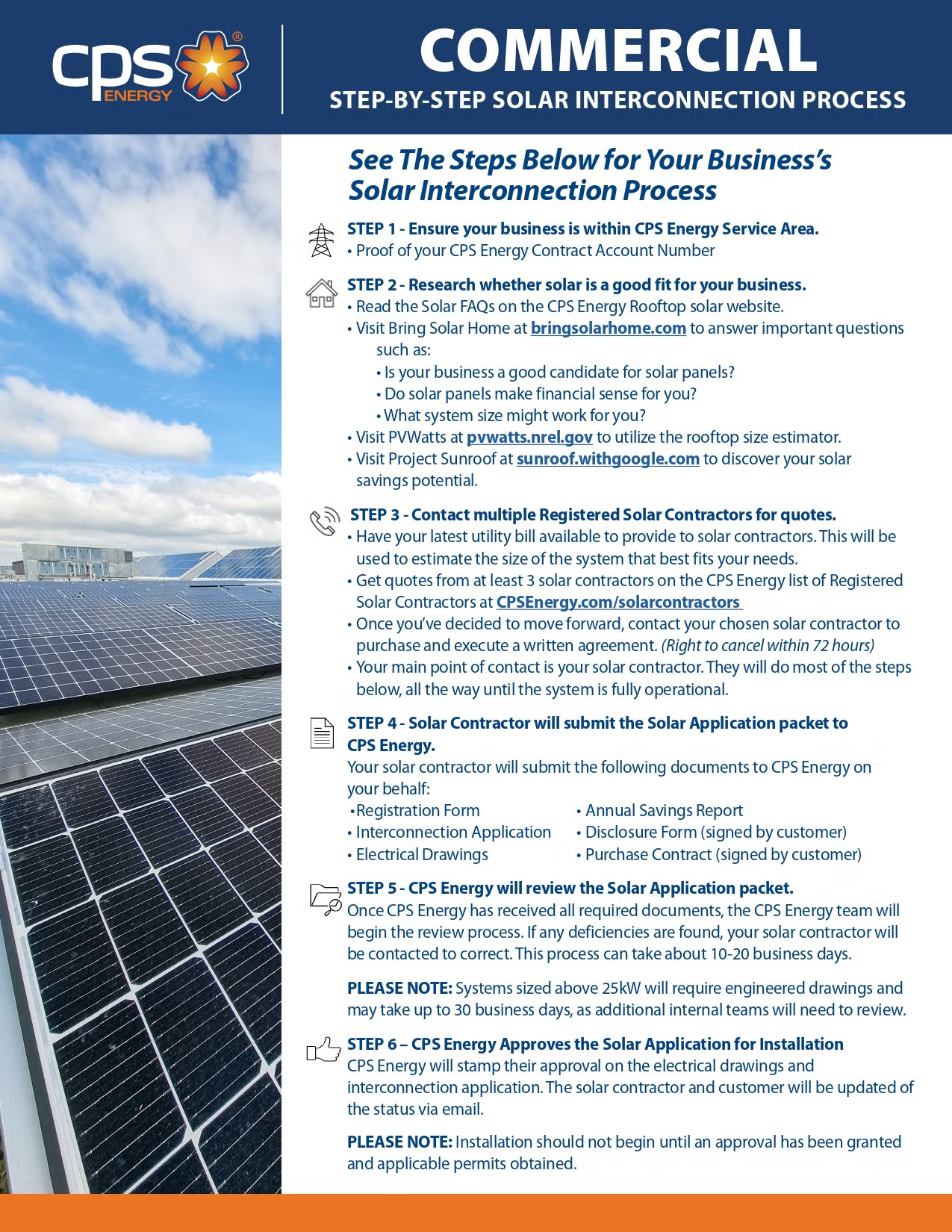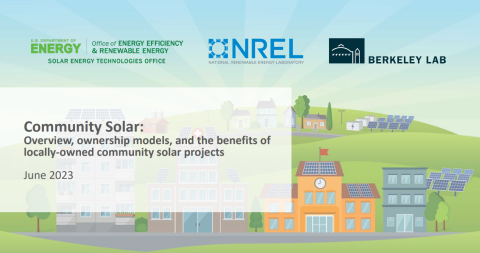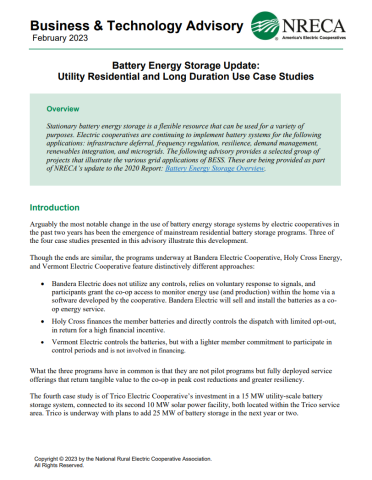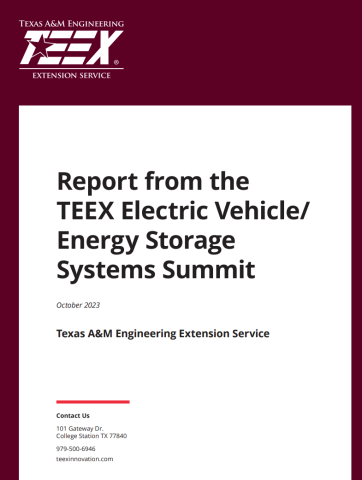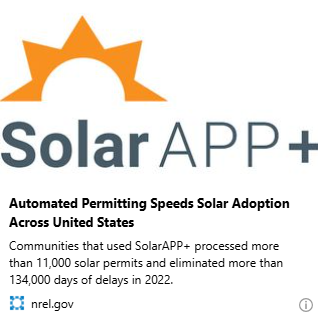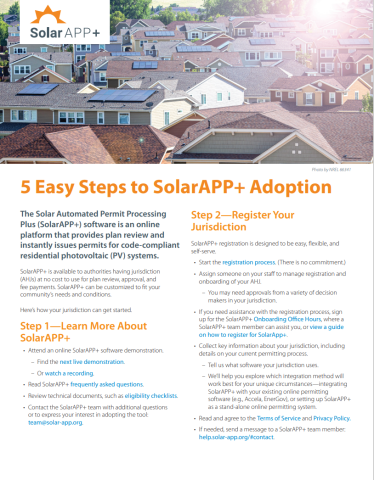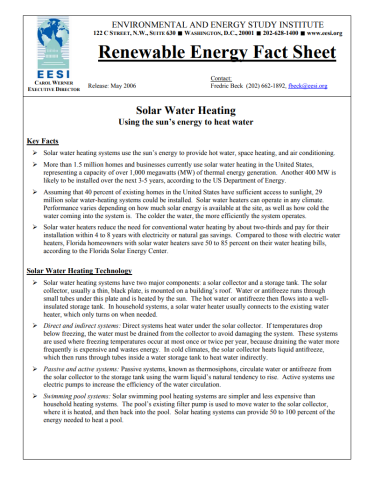Funded by the U.S. Department of Energy, SolSmart recognizes and celebrates local efforts to expand solar energy with SolSmart designations of Platinum, Gold, Silver, and Bronze. The program has supported over 500 local governments in becoming solar leaders by providing no-cost technical assistance to streamline solar processes, address local barriers, and maximize economic and energy benefits. The Alamo Area Council of Governments (AACOG) is currently pursuing SolSmart designation. As part of our mission, we want to encourage more cities and counties in our region to pursue designation and adopt best practices for easier solar energy installation and access in their communities. This webpage offers a collection of solar information and resources for the region.
- How Does Solar Work?
- Considerations Before Installation
- How to Install Solar?
- Interconnection Details
- Financing and Incentives
- Solar Rights and Regulations
- Real World Applications
- Events/Trainings
According to the U.S. Energy Information Administration, in 2022, Texas was the nation’s second-largest solar energy producer. Texas holds the advantage of being one of the top states in the U.S with consistently sunny weather, making it an ideal location for reliable solar energy production. With electricity demand expected to increase in the next decade, Texas must prepare to meet these needs and navigate periods of strain on the grid. Solar energy investment represents a golden opportunity for the state to meet the increase in economic development and demands of a growing population. It can also empower property owners to gain independence from the grid and remain in operation during outages. Before investing in solar, it is important to know what it is and the current technology available to consumers.
What is Solar Energy?
Solar energy or solar radiation is light and heat emitted from the sun that is collected and converted into electrical energy either through photovoltaic (PV) panels or concentrating solar thermal power. It proves to be one of the Earth's most abundant and clean energy sources that does not require fossil fuels.
Photovoltaic (PV) panels
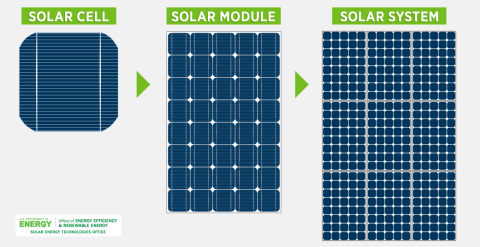
Photovoltaic (PV) panels also known as solar panels absorb and convert sunlight into electrical energy through semiconducting materials found in a singular solar cell. Singular solar cells are connected together to form panels or modules which are then connected to create a complete solar PV system. Solar PV systems are connected to the electrical grid and send converted electrical currents back into the electrical system that powers your building. The number of solar panels in your system depends largely on location, building size, and energy consumption. Due to its smaller scale, solar PV is best used at a residential and commercial scale.
Concentrating Solar Thermal Power (CSP)
Concentrating solar thermal power uses mirrors to reflect and concentrate sunlight onto a receiver that then converts it into heat. The heat is converted to steam to produce electrical power through a steam turbine. This technology is primarily installed as a large-scale utility facility in the form of towers, dishes, linear mirrors, and trots.
Solar Energy Storage Systems
Solar energy storage systems are a technology that can be paired with solar PV systems to store the electricity produced during the day in optimal conditions to use at any time regardless of cloudy conditions or it being nighttime. There are two forms of storage systems—short-term storage that allows for operation during short fluctuations that lasts a few minutes or longer-term storage that provide days or weeks worth of stored power when solar energy production is low or there are weather-related outages. The Solar Energy Technologies Office offers a list of the different types of storage systems, including, batteries, thermal, and mechanical (hydropower) systems.
Community Solar
Community solar programs are local solar facilities or projects that are shared by the community. Customers subscribe or own a portion of the solar PV system associated with a community solar program. In return, they receive credits on their electricity bills for their share of the solar power produced on an offsite location. These programs can break down barriers for residents, businesses, and cities to secure access to solar without having to worry about rental property restrictions or compatibility with an individual's home or business.
Are Solar Panels a Good Fit for You?
Before installing solar, it is important to first understand whether your home or building is suited for solar.
Consider roof orientation
Ideally, the best roofs suited for solar generation are those that are south-facing with a slope between 15 and 40 degrees which receive direct sunlight from sunrise to sundown. Solar panels that are not south-facing may still be viable options, but they wont be nearly as efficient. Take note of any shade trees that may interfere with sun exposure.
Consider your roof condition, material, and size.
Not all roofing materials are suited for solar panels. Roofing materials such as asphalt shingles, tile, and metal roofs make for excellent materials to provide a secure base. In addition to roofing material, the size of your roof must be enough to accommodate the required number of panels to power your system. When installing solar, it is important to consider the age and condition of your roof. Can it withstand the weight of a solar system? Is there any noticeable damage such as curling, cracked, or missing shingles? If your roof is more than 10 years old, it is advisable to have it surveyed or install a new roof before putting on solar PV panels.
Consider roof ownership
Do you own or rent the building or home you plan to install solar on? Homeowners who purchase their system benefit the most from tax incentives. Renters and people with homes that aren't suitable still interested in solar may consider community solar.
How long will it take to see savings/return on investment?
A solar PV system is a long term investment with an average payback period of 6-10 years. A payback period is the amount of time it will take to pay off your solar PV system through savings. The amount a solar system saves you varies widely and depends upon the total cost of your system, tax incentives/rebates received, utility costs in your area, and your home's total energy consumption.
To get a detailed estimate of solar panel cost, total energy savings, and payback periods for your specific home or business, simply enter your address into Google's Project Sunroof.
Most solar companies offer free quotes to prospective buyers, where they request your annual electricity usage and research your property’s solar exposure to offer a professional estimate. Alternatively, you can calculate your payback period by dividing the net cost of going solar after incentives by your annual savings. You can find detailed instructions on how to calculate the solar payback period on EnergySage's website.
Consumer Protections
Before entering into an agreement, it is important to thoroughly research and get quotes from different solar companies, look at company reviews, check their licensure, compare warranties and pricing details. When shopping for solar, be wary of high-pressure sales tactics or misleading claims. Understand the full terms of your contract – exactly what they are providing and how much you are paying for it.
Some warning signs to look out for
- Exaggerated claims of upfront costs that seem too good to be true
- Ads or quotes that state tax incentives or prices are only available for a limited time
- Promises of free solar panels—these often come with fine print of paying a third-party that owns the system
- Claims that you have only one specific choice of equipment
Some questions to ask before entering an agreement include
- Under this plan, who owns the solar panels and receives the tax incentives?
- Who would be responsible for maintaining the panels?
- What brand of solar panels and batteries would be used?
- What happens with the panels if the house is sold to someone new?
- What do the warranties cover and what are their durations?
- If the company fails, who should I contact regarding panel and inverter warranties and replacements?
- Are you state licensed or a member of the Solar Energy Industries Association (SEIA)?
Find other useful resources on solar rights, consumer protection, and procedures.
- Consumer Solar Checklist – a checklist for residential consumers considering solar energy from IREC, the Interstate Renewable Energy Council.
- Clean Energy Consumer Bill of Rights – understand your rights as a consumer from IREC, the Interstate Renewable Energy Council.
- SEIA Residential Consumer Guide to Solar Power– useful questions to ask solar companies when negotiating a contract for all types of solar systems, leased, or financed.
- Solar United Neighbors: this nonprofit offers homeowners and businesses free services such as an analysis of your roofs compatibility with solar, 15 minute phone consultations with solar experts, and a review of a solar installer's quote/proposal.
After considering your options, you have decided to install solar. Initiating the solar installation process can seem daunting, but this section aims to simplify and outline the essential steps required for successfully installing a solar PV system in Texas. With the right strategies and planning, you can ensure that you get the most out of your investment in a solar PV system.
Evaluate your Energy Needs
Before sizing your solar system, consider performing energy efficiency upgrades to your home/building. You may be able to reduce the costs of your solar system by reducing the total amount of energy your system would have to support. An energy audit identifies areas of waste and pinpoints underperforming areas that require improvements. Check with your utility provider, if they provide free or discounted home energy audits.
Residential Properties
- Energy Efficient Home Improvement Tax Credit: the home energy audit tax credit offers 30% of the cost of a home energy audit, up to $150 per year.
- Residential Energy Service Network (RESNET): RESNET offers a database of certified home energy assessors.
- CPS Energy No-Cost Home Energy Assessment: a trained energy expert will evaluate your home and recommend ways to make it as energy efficient and comfortable as possible for free.
- AACOG Weatherization Assistance Program: provides free energy efficiency upgrades such as air sealing, insulation, lighting retrofits, refrigerator upgrades, furnace repair/replacements, and hot water system improvements to residents in AACOG region.
Commercial/Industrial Properties
- Energy Star Portfolio Manager: this free, web-based tool designed for commercial, institutional, and industrial facilities to benchmark their buildings' energy consumption, waste, water use, and greenhouse gas emissions.
- Texas A&M Building Performance Assessment Center: the Texas A&M Building Performance Assessment Center provides no-cost building energy usage assessments for eligible commercial buildings.
Public Facilities
- Preliminary Energy Assessments: SECO provides free energy assessments for public facilities, offering a thorough evaluation of your facilities to identify current energy usage patterns and recommend opportunities for energy savings.
System Design
Types of Solar Panels
Monocrystalline panels are made of pure silicon and are the most effective at converting sunlight into electricity. These are typically the most expensive type of panel due to their efficiency and manufacturing process that extracts a silicon crystal and undergoes a process called the Czochralski method to create a cell that is then joined to make a panel. Due to their size, they are best for areas with limited space. They have an average lifespan of 25-40 years.
Polycrystalline panels are made using silicon fragments rather than a single crystal, making them less expensive. These panels are comparable to monocrystalline but they are slightly less efficient to their monocrystalline counterpart. These fragments are melted together and cooled to be then sliced and adjoined to create a panel. They have an average lifespan of 20-35 years.
Thin-film panels are the newest and cheapest type of solar PV panel, however, they are the least efficient. These panels are not sourced from pure silicon but rather made of multiple materials such as cadmium, copper, silicon, and gallium. They have an average lifespan of 10-20 years.
Efficiency
Efficiency refers to the amount of energy solar PV panels can produce.
- Monocrystalline panels typically have the best efficiency at 15-20%.
- Polycrystalline panels come close, generally having an efficiency of 13-16%.
- Thin-Film panels, vary in efficiency from 7-18% based on their size.
Types of Solar PV Systems
Grid Tied systems allow owners to receive electricity from both their solar PV system and the utility power grid. If there is an interruption or gap in electricity production, the utility grid will supply the home with backup power. If more electricity is produced than needed, the energy is sent back to the grid and often times, customers are able to receive credits on their utility bill through net metering. This is the most common type of system due to its affordability.
Off-grid systems have no connection to the utility grid and produce all the electricity load. They are typically accompanied by battery storage systems or another backup power source such as a generator which allows a home/building to remain in operation during outages or weather interruptions. These systems are more expensive due to the battery storage needs but are ideal for those who don't have grid access or have small energy loads.
Hybrid systems combine aspects of grid-tied and off-grid systems. The solar panels remain connected to the utility grid but have attached battery energy storage systems, allowing for the owner to use stored energy during outages. Owners who experience frequent grid outages or are not eligible for net metering can benefit most from these type of systems.
Finding a Contractor
According to the U.S. Department of Energy's National Renewable Energy Laboratory (NREL) homeowners who get 3 or more quotes from installers save at least 10% on their systems.
Property owners can submit a request for solar quotes from a network of pre-screened, local solar installers on EnergySage's website. When choosing an installer, double check if they are a certified solar practitioner through North American Board of Certified Energy Practitioners NABCEP professional directory.
Permits and Regulations in Texas
After selecting your solar installation contractor and signing an agreement, an engineer will inspect your home to evaluate the compatibility of your electrical system and the structural integrity of your roof. Once evaluated, the owner must sign an interconnection agreement with the utility company and pay for necessary permits, including, electrical and building permits required by local ordinance. Check with your local city development services department if you want to know what permit costs are. After obtaining permits, the contractor will be able to initiate installation and order equipment. Once the solar installation is complete, a city representative will conduct a final inspection to review the safety of the system and if it is up to code. After this final inspection, the system will then be allowed to operate or be connected to the energy grid.
During this step of the process, owners should ask and apply for state and federal incentives. To learn about incentives in your area, visit the national Database of State Incentives for Renewable Energy (DSIRE) or explore our financing and incentives tab.
Maintenance Costs
Solar panels require very minimal maintenance. Rainfall typically cleans solar panels, however, it is recommended to conduct at least one annual cleaning to maintain their performance. According to EnergySage, annual cleanings cost between $150 and $300. However, make sure to ask installers if they offer a solar maintenance package as part of their warranty which can include cleaning, system performance checks, and pest control measures such as critter guards.
Insurance/Warranties
Solar panels are designed to withstand all the elements—hail, heavy rain, snow, and heavy winds but they are not foolproof. When purchasing solar panels, it is important to consider adding on warranty in cases you need to repair or replace the system. Look for contracts that offer:
- Power Output Warranty: ensure that solar panels will perform at a specific production level over the warranty period
- Product Warranty: repairs or replaces damaged or defected parts.
Before connection, check with your insurance provider on their requirements and if the solar system will need to be added to your existing policy.
Interconnection is the process through which an energy resource is connected to the electricity grid. Interconnection processes and fees vary by municipality. Make sure to double check with your utility about details on interconnection processes before you connect your solar arrays and battery storage system. We have compiled utility-specific resources and regulations in the region for communities to reference.
CPS Energy
Bandera Electric Cooperative
Access the full Procedures and Guidelines for Member-Owned Distributed Generation HERE
Note: In order to receive service from the Cooperative, a customer must join or become a “Member” of the
Cooperative.
Gudalupe Valley Electric Cooperative
Medina Electric Cooperative
Distributed Generation Interconnection Process
Read Medina Electric Cooperative's Solar FAQ here. Read more about Interconnection Process here.
Members interested in interconnecting DG to Medina EC’s system should:
- Consult with a qualified DG developer, installer or electrical consultant to determine technical requirements and potential costs.
- Call 1-866-632-3532 or email us at Info@MedinaEC.org and let us know you are considering a DG system.
- Read and understand the DG portion of the tariff to ensure that all provisions will be followed. Please make note of the insurance requirements. Medina EC does require the owner of any DG system on our lines to show proof of liability insurance of at least $300,000 per occurrence. This can extend from your homeowner’s policy or be covered under an umbrella policy, depending on what your agent says. The cooperative will accept a declarations page or certificate of insurance stating the amount of coverage.
- Complete the DG Application and return it to Medina EC with the application fee and a system design document created by an acceptable commercial software.
- Schedule a time for a Medina EC representative to visit the proposed DG facility.
- Complete the DG Interconnection Agreement and return it to Medina EC along with any necessary insurance documents.
- Give Medina EC the opportunity to witness or verify the testing of the DG facility.
- If system testing is approved and all conditions of the interconnection agreement are satisfied, the DG facility is eligible to operate in parallel with the electric distribution facility of Medina EC.
How much does it costs to interconnect with the co-op?
Nonrefundable Application Fee
- Systems 10 kW or smaller = $0
- Systems 11 kW to 50 kW = $25
- Systems 51 kW to 1 MW = $700
- Over 1MW to 10MW = $1,000
Possible Additional Charges
- If an interconnection study is required, the member will be required to compensate Medina EC for the cost of the study.
- If system improvements or lines extensions are required, the member will be required to pay the cost of those.
- If the system is larger than 700 kW, South Texas Electric Cooperative will also require a separate application and fee for an interconnection study.
- Interconnection is a one-time fee. There is a added monthly service charge for systems larger than 1MW.
Since 2010, the prices of solar photovoltaic panels have decreased by 70%, however, solar installation costs and financing remain one of the barriers to solar installation. Typically, solar photovoltaic (PV) systems are financed through a combination of loans, upfront cash payments, or power purchase agreements (PPAs). Consumers interested in purchasing and installing a solar system should also explore federal, state, and local incentives that can make solar energy a more affordable and viable option.
Federal Incentives
- Tax Credit for Solar Photovoltaics: The federal government offers the Federal Investment Tax Credit for residential solar that allows homeowners to deduct 30% of the solar PV system’s cost from their income taxes. Learn about the federal tax credit, eligibility, and other common questions & answers from the U.S. Department of Energy.
- Federal Solar Tax Credits for Businesses: Business owners are also eligible to receive 30% tax credits to purchase and install solar energy systems. Learn an overview of the Investment Tax Credit and the Production Tax Credit, the eligibility requirements, and commonly asked questions.
- Bonus Credits: Some commercial solar projects are eligible for bonus credits on top of the 30% Investment Tax Credit. The Inflation Reduction Act provides up to 20% in bonus credits for qualified solar or wind facilities developed in low-income communities; up to 10% bonus for projects located in “energy communities” that have a historic fossil-fuel economy, high unemployment or are developing solar on a brownfield; and 10% domestic content bonus for projects using the required amounts of U.S.-produced steel, iron and manufactured products.
- Tax-exempt organizations, including non-profit organizations, schools and government entities, can now take advantage of the federal tax credit through “elective pay” (sometimes referred to as “direct pay.”) The IRS has made available Frequently Asked Questions and an overview of elective pay
- USDA - Rural Energy for America Program (REAP) Loan and Grant Program: Provides loan financing and grant funding to agricultural producers and rural small businesses for small and large solar generation.
State Incentives
- Property Tax Exemption Texas offers a 100% property tax exemption for solar system installations, increasing the value of your property with no affect to your property taxes.
- LoanSTAR Revolving Loan Program: Low interest financing is available for state, public school, college, university, and non-profit hospital facilities to pursue energy-related cost reduction retrofits for state, public school, college, university, and non-profit hospital facilities to install solar projects. Borrowers repay loans through cost savings realized from their energy cost-reduction projects.
- Property Assessed Clean Energy (PACE): Long term, low interest financing is available for commercial and industrial building owners to install solar on their property repaid via a lien on the property. Check if your city/county has adopted PACE.
Local Incentives
Local incentives are available to residential, commercial, and industrial building owners through rebates popularly offered by the utility company or the city. A rebate is a partial refund or discount received after an eligible purchase/installation.
- CPS Energy- Energy Solar Rebate Program: Rebates are available for residential solar PV projects with a cap of $2,500 per project and a $500 premium for projects utilizing local modules
- CPS Energy- Solar Rooftop Rebates: Small businesses, schools, and non-profit organizations are eligible for rebates on installing solar systems. CPS customers can expect to be covered up to $80,000 or 50% of the cost.
- $0.60 per AC Watt for the first 25kW, $0.40 per AC Watt for kW over 25
- $0.10 per AC Watt premium for projects utilizing local modules
- CPS Energy - New Residential Construction Incentives: CPS Energy offers free assistance and rebates up to $1000 to builders and contractors for homes that are built at least 15% more energy efficient than 2021 International Energy Conservation Code (IECC) specifications.
- CPS Energy - Solar Hot Water Rebate Program: CPS Energy offers rebates for installing solar water heaters. The maximum rebate award is $2,000.
- CPS Energy Solar Net Billing: Customers whose solar panels produce more electricity than they need are able to sell excess energy to CPS for $0.02 per kWh as a credit on their electricity bill.
- New Braunfels Utilities - Solar Rebate Program Customers may earn up to a $3,000 rebate by installing a qualifying solar PV system on their home or business
- Bandera Electric Cooperative (BEC) Energy Saver Program: BEC allows members to finance the cost of a solar system, battery storage, and/or electric vehicle (EV) charging infrastructure on their bill with zero-down and no interest. Additionally, they offer cash discounts for solar systems installed by BEC.
- Guadalupe Valley Electric Cooperative (GVEC) Community Solar Program: GVEC members are able to purchase local, renewable energy at no cost without having to fund or install a solar panel system on their homes.
- City of Pearsall's Just Energy’s Texas Solar Buyback Program: Just Energy customers can receive bill credits for excess energy.
Incentives for Low Income and Disadvantaged Communities
- Low Income Home Energy Assistance Program (LIHEAP): Grant recipients may request to use funds to directly pay for community solar subscriptions or solar bills.
- Weatherization Assistance Program (WAP): Grantees may request approval for solar rooftop systems or solar water heaters as an eligible covered expense through a Special Materials Request (WPN 23-6 Attachment 6).
- Solar for All Program: Minority Serving Institutions and Community Based Organizations can apply for grant funding to bring community solar to low-income communities.
- RE-volv Financing for Nonprofits: provides solar system financing (solar loans, PPAs, and leases) for nonprofits including schools, food banks, homeless shelters, and houses of worship with no upfront costs.
Solar Loans
- Solar loans allow owners to borrow money from a lender or solar developer to install a solar PV system.
- Property owner owns the installed system.
- Various loan options available with different monthly payments, interest rates, loan lengths, credit requirements, and security mechanisms.
Solar Power Purchase Agreements
- A solar finance company buys, installs, and maintains a solar system on the owner's property.
- Property owner purchases the generated energy on a per-kilowatt-hour basis through a long-term contract at rates competitive with the local electricity prices.
- Benefits: No upfront costs and no responsibility for system operations and maintenance.
Solar Leases
- Property owners make scheduled payment, usually monthly, to a developer who installs and owns the solar system.
- A typical lease term is 15-20 years.
- Benefits: Eliminates most or all upfront costs and transfers operations and maintenance responsibilities to the developer, if specified in the contract.
For more information and a comparison of financing options, explore the Homeowner’s Guide to Solar Financing
Texas has passed several solar access laws protecting a homeowner’s right to go solar. This section provides a summary of the rights and regulations for homeowners when installing solar panels.
- Texas Property Code Section 202.010: Forbids HOAs and property owners associations from outright prohibiting a property owner from installing a solar energy device as defined by Texas Tax Code Section 171.107.
- Except under the following conditions
- If the solar energy devices are illegal or violate public health and safety
- If they are located on common property within the subdivision
- If they extend higher than the roofline, do not conform to the slope of the roof, or are not parallel to the roofline
- If they are ground-mounted and extend above the homeowner’s fence
- If they are installed in a way that voids the warranties
- If they have an element that is not in a silver, bronze, or black tone
- If they are installed without prior approval by the HOA
- HOA's can designate where solar panels may be placed, however, homeowners can petition for an alternate location if the location chosen by the HOA would decrease the estimated annual energy production of the solar panels by more than 10%.
- Except under the following conditions
- HB 362: HOA homeowners must follow the normal procedures for seeking improvements, including a written request or application for solar installations to an appointed Architecture Review Committee or similar council.
- Texas Tax Code 11.27: Ensures homeowners and businesses do not have to pay additional property taxes based on the value of installing solar panels.
- Texas Property Code Section 209.006: When disputes arise, HOAs must issue a formal notice of violation, outlining the rule allegedly violated and providing a deadline for the homeowner to respond. Under this code, homeowners must be given an opportunity to request a hearing before the board to protest. If the dispute is not resolved internally, homeowners can seek legal intervention.
- SB 1626: Allows developers to prohibit homeowners in residential subdivisions from installing solar panels on their homes during the development period only if the development consists of 50 or fewer units
Read case studies and success stories of how solar energy has been promoted, utilized and adopted across Texas. Learn from Texas cities and utilities about their programs, solar sites, and best practices.
City of San Antonio—Challenges and Successes on the Path Toward a Solar-Powered Community
The City of San Antonio was designated by the U.S. Department of Energy (DOE) on March 28, 2008, as a Solar America City and designated silver through the SolSmart program in 2017. Learn how the city of San Antonio became open for solar business by reading through a case study on their strategic policies, their “Bring Solar Home” Marketing Campaign, Blue Wing Utility-Scale Solar Project, and “Level 3 Solar Home,” a Net-Zero Model Home for the local building community.
Community Solar Overview
The U.S. Department of Energy and the National Renewable Energy Laboratory (NREL) present a slide deck with an overview of community solar. It introduces community solar programs and their benefits, explains different ownership models, and ends with the best practices to keep in mind when starting a locally-owned community solar project.
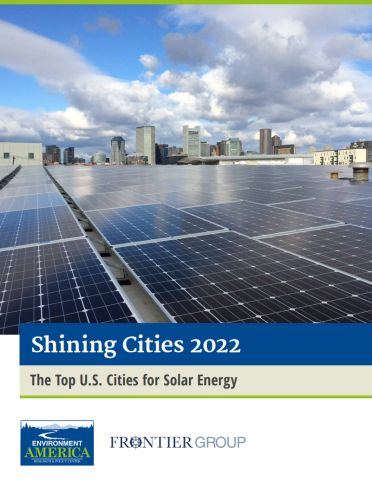
Environment Texas — Shining Cities 2022: The Top U.S. Cities for Solar Energy
Environment Texas provides examples of what the cities with the most solar PV are implementing in their regions. This report offers recommendations and best practices for local, state, and federal governments on pro-solar policies
National Rural Electric Cooperative Association — Solar Battery Energy Storage Use Cases
NRECA (National Rural Electric Cooperative Association) offers a case study and lessons learned from electric cooperatives, such as the Bandera Electric Cooperative, in their application of their residential battery solar energy storage programs.
Texas A&M Engineering Extension Service ( TEEX) Report on Electric Vehicle/Energy Storage Systems Safety Precautions
TEEX created a report on best practices for local government officials and first responders to respond and prevent Lithium-ion battery incidents.
National Renewable Energy Laboratory (NREL) — Automated Permitting Speeds Solar Adoption Across United States
NREL released their 2022 performance review on the Solar Automated Permit Processing Plus (SolarAPP+) software—developed by the National Renewable Energy Laboratory (NREL). Learn how automatic processing speeds the permitting process and makes it easier to issue permits for residential PV systems and solar-plus-storage systems.
National Renewable Energy Laboratory (NREL) — 5 Easy Steps To Solar APP+ Adoption
The Solar Automated Permit Processing Plus (SolarAPP+) software is an online platform that provides plan review and instantly issues permits for code-compliant residential solar PV systems. NREL explains 5 steps towards adopting the software in your jurisdiction.
Environmental and Energy Study Institute (EESI) Fact Sheet on Solar Water Heating
EESI gives a fact sheet on how to provide hot water, space heating, and air conditioning using solar energy via solar water heaters. They provide information on their costs, benefits and how the technology operates.
Upcoming Workshops and Roundtables
Past Events
Pathway to Bronze Designation
Date: July 31st from 10:00-11:00AM
The Alamo Area Council of Governments presents the final workshop in our SolSmart series: The Pathway to Bronze.
This session is open to all communities—whether you’re just getting started or have already taken steps to support solar development. A SolSmart Bronze designation is a nationally recognized achievement that highlights leadership in expanding solar access and affordability.
The World Resources Institute will guide participants through the SolSmart designation process, explain the various designation levels, help identify areas where communities may already qualify for points, and share practical actions to advance toward or beyond Bronze.
Lithium-Ion Battery Awareness Training
Date: June 26, 2025 from 9:00 AM-1:00PM
The Alamo Area Council of Governments and the Texas A&M Engineering Extension Service hosted a no-cost Lithium-Ion Battery Awareness Training at 2700 NE Loop 410 Suite 101 San Antonio, TX 78217.
Jeremy VanAusdall, Battalion Fire Chief for the City of New Braunfels provided expert guidance on managing electric vehicle (EV) and energy storage system (ESS) fires and related emergencies.
Lithium-ion battery technology is relatively new, and this training is designed to equip emergency departments and first responders with the necessary expertise on battery technology and the related incidents that can occur. Attendees will learn best practices for responding to this evolving technology, including proper risk assessment, fire suppression techniques, and post incident strategies.
Community Engagement & Municipal Operations for Solar Arrays
Date: June 5th, 2025, from 10:00 AM-11:30 AM
The Alamo Area Council of Governments hosted the fourth session in our SolSmart series: Community Engagement & Municipal Operations for Solar Arrays.
Local governments hold the key to solar energy’s success—learn how you can support solar development in your community and engage more residents and businesses to consider the benefits of adopting solar energy. During this session, the World Resources Institute will also provide local governments with key considerations and best practices for municipal procurement of solar for their facilities.
Permitting and Inspection Training
Date: April 24th, 2025 Time: 10-11:00 AM CT
Join the Alamo Area Council of Governments and the World Resources Institute for the third session in our SolSmart series on Permitting and Inspection: Best Practices for Solar Arrays on Thursday, April 24th from 10:00 AM-11:00AM. This session will provide insights into solar installations and how to best permit, inspect, and navigate these systems.
Attendees will discuss how to review their current permitting process, identify opportunities to streamline them, and develop a “permitting checklist” outlining the required permits, submittals, and steps of their community’s permitting process for residential rooftop solar PV.
We recommend that prior to watching the discussion, interested permitting and inspection staff watch NCTCOG’s SolSmart training on best practices and considerations for solar permitting and inspections.
Location: 2700 NE Loop 410, Suite 101 San Antonio, TX 78217
Planning for Solar Training
Date: March 27th, 2025 Time: 10-11:30 AM CT
Join the Alamo Area Council of Governments (AACOG) and the World Resources Institute (WRI) for a free in-person training that will provide planning and zoning staff with strategies for incorporating solar into plans, ordinances, and development regulations.
A local government’s approach to zoning and development can have a significant impact on solar energy growth. The inclusion of solar energy planning and zoning best practices provides a foundation that can help facilitate the growth of solar energy, while balancing other development priorities in a community. Attending this workshop earns planners continuing education credits from the American Planning Association and points toward SolSmart designation. To qualify for AICP credits, participants must attend the session either in person or remotely at the scheduled event time.
Location: 2700 NE Loop 410, Suite 101 San Antonio, TX 78217
Setting the Stage for Solar Development & the SolSmart Cohort
Date: February 27th, 2025 Time: 10-11:30 AM CT
Join the Alamo Area Council of Governments (AACOG) and the World Resources Institute (WRI) for the first workshop in our SolSmart series, Setting the Stage for Solar Development & the SolSmart Cohort.
This in-person workshop will explore the solar landscape in Texas, discuss its benefits to our electricity system, and provide an in-depth orientation to the SolSmart Cohort for interested member cities and counties. We will cover the core issues the cohort will address, key staff to engage, and guide you through the first steps to take as part of the cohort.
Learn how your city or county can join AACOG’s SolSmart cohort and benefit from free training on nationwide best practices in solar permitting, inspection, planning, and zoning.
Location: 2700 NE Loop 410, Suite 101 San Antonio, TX 78217
Introduction to SolSmart-Helping Local Governments Offer Solar Energy to Residents and Businesses Webinar
Date: January 28th, 2025 Time: 11-12:00 PM CT
The Alamo Area Council of Governments (AACOG) is spearheading a regional effort to encourage our member governments to participate in the Department of Energy’s SolSmart program as part of the Alamo Area’s SolSmart cohort. Since 2016, the SolSmart program has offered free technical assistance to hundreds of local governments across the nation, helping remove red tape and barriers to solar energy investment. Our goal is to guide our local governments through the program, qualifying you for a prominent designation where you will join a peer network of over 500 leading communities in solar energy across the country.
Are you ready to make solar energy more accessible to your community? This webinar is perfect for local governments looking to join the program or to enhance their designation.
Webinar Details:
• Overview of SolSmart: Understand what SolSmart is and how designation process works.
• Program Benefits: Explore the advantages the program offers, including technical assistance and support for Planning, Zoning, Permitting, and Code Enforcement staff.
• Community Impact: See how SolSmart can help your city/county achieve its energy and climate goals.
• Next Steps: What involvement with the Alamo Area’s SolSmart Cohort looks like.

 Home
Home